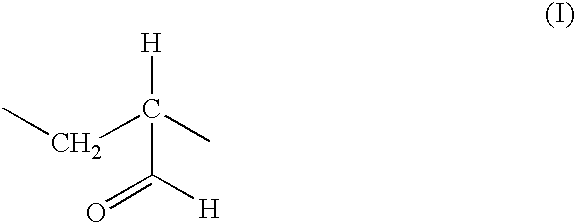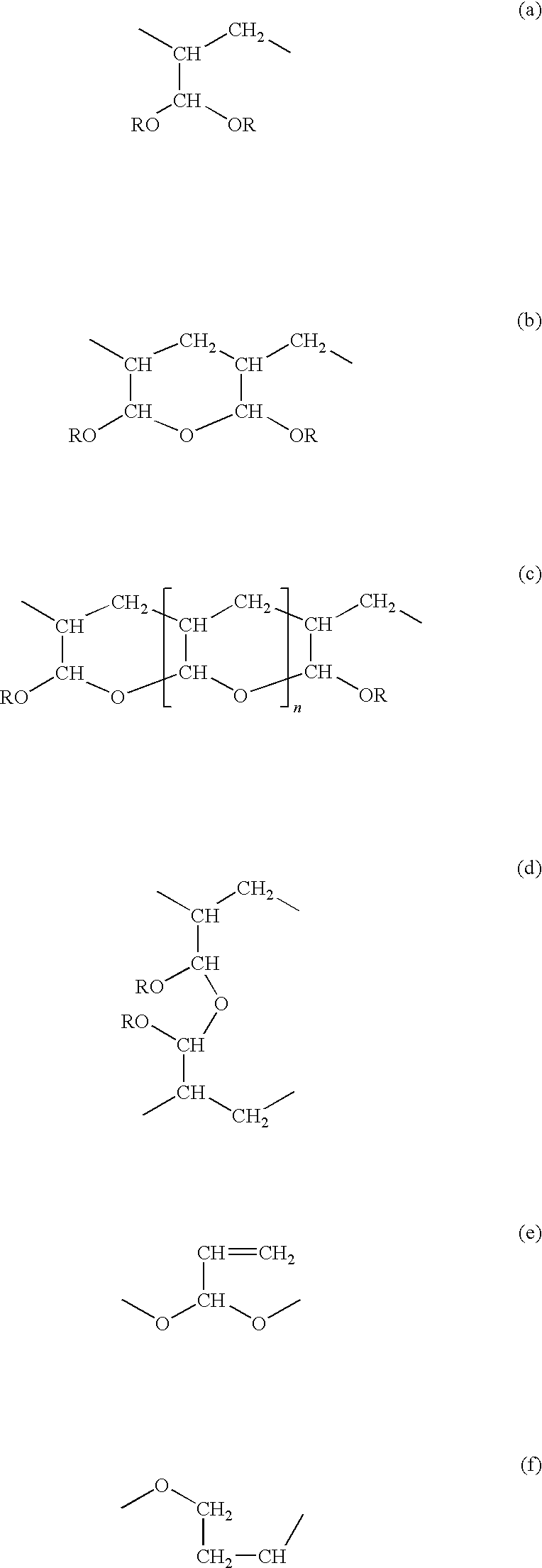Antimicrobial polymeric compositions and method of treatment using them
- Summary
- Abstract
- Description
- Claims
- Application Information
AI Technical Summary
Benefits of technology
Problems solved by technology
Method used
Image
Examples
example 1
[0105]The example describes a method of preparing poly(2-propenal, 2-propenoic acid) by oxidation of a solid acrolein polymer in air. This poly(2-propenal, 2-propenoic acid) is the preferred method of preparing a starting material for use in the method of the invention. Water (720 mL at ambient temperature, about 20° C.) and acrolein (60 g; freshly distilled, plus hydroquinone added to 0.25% w / w) were placed in an open beaker, within a fume cupboard, and very vigorously stirred, mechanically. Then, 0.2 M aqueous sodium hydroxide (21.4 mL) was added to bring the pH 10.5-11.0.
[0106]The solution immediately turned a yellow typical of the hydroquinone anion and within a minute, the colour had disappeared and the clear solution became milky.
[0107]About 1 minute later, precipitation of a white flocculent polymer began, and appeared complete within 15-30 minutes. The precipitate was filtered and washed with water (250 mL), dried at room temperature upon filter papers for 2 days (yield 25 g...
example 2
[0110]This example describes acetal formation from poly(2-propenal, 2-propenoic acid).[0111](a) 5 g of poly(2-propenal, 2-propenoic acid) was dissolved in 64 g polyethylene glycol (“PEG”) 200 and combined with 31 g of a 0.71% w / w solution of sodium carbonate. A portion of the solution (apparent pH=5.8) was retained at room temperature while[0112](b) the remainder of the sample from part (a) was heated at 60° C. for periods of 12 or 25 days.
[0113]Samples from (a) and (b) were diluted with 1% w / w sodium bicarbonate and submitted for biocidal testing at polymer concentrations of 0.125% w / w. Surprisingly, the samples which had undergone “accelerated ageing” showed improved antimicrobial activity, as can be seen by reference to Table 1:
[0114]
TABLE 1Cfu / mL* (Pseudomonas aeruginosa)Sample0 min10 min15 min30 min60 min25 days7.8 × 1064.1 × 1066.1 × 1059.8 × 104at roomtemperature12 days at7.7 × 1061.4 × 1069.8 × 10360° C.25 days at1.0 × 1071.3 × 1066.6 × 10460° C.*Colony forming units / mL
[0115...
example 3
[0119]This example examines the product produced by reaction of the poly(2-propenal, 2-propenoic acid) with polyethylene glycol.
[0120]The poly(2-propenal, 2-propenoic acid) of Example 1a was dissolved in a PEG 200 and 31 g of 0.71% w / w solution of sodium carbonate at pH 5.8. This composition was divided into two samples.
[0121]Sample A was retained at room temperature and examined to determine the properties of normally activated poly(2-propenal, 2-propenoic acid) in PEG 200.
[0122]Sample B was heated to 90° C. for two hours to cause the PEG and poly(2-propenal,2-propenoic acid) to react to form superactivated product.
[0123]Sample A and Sample B were examined by 1H Nuclear Magnetic Resonance (NMR) spectra at 600 MHZ.
[0124]The spectra of the compounds and the assignment of signals is shown in the table below.
[0125]
Table of 1H NMR SpectraNormallySuperActivatedActivatedδ (ppm)Groupsδ (ppm)Groups1.1-2.9—CH—, —CH2—1.0-2.—CH—, —CH2—3.3-4.8—CHO—, —CH2O—3.3-5.1—CHO—, —CH2O—3.6—CH2O— (PEG)3.6C...
PUM
| Property | Measurement | Unit |
|---|---|---|
| Percent by mass | aaaaa | aaaaa |
| Percent by mass | aaaaa | aaaaa |
| Percent by mass | aaaaa | aaaaa |
Abstract
Description
Claims
Application Information
 Login to View More
Login to View More - R&D
- Intellectual Property
- Life Sciences
- Materials
- Tech Scout
- Unparalleled Data Quality
- Higher Quality Content
- 60% Fewer Hallucinations
Browse by: Latest US Patents, China's latest patents, Technical Efficacy Thesaurus, Application Domain, Technology Topic, Popular Technical Reports.
© 2025 PatSnap. All rights reserved.Legal|Privacy policy|Modern Slavery Act Transparency Statement|Sitemap|About US| Contact US: help@patsnap.com



